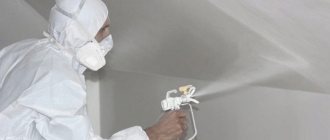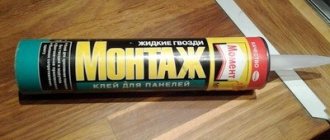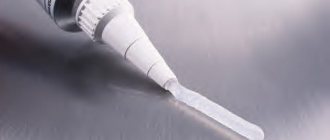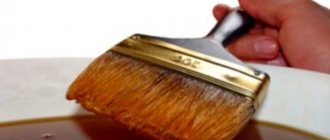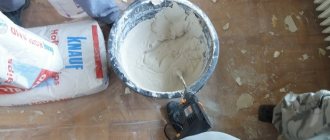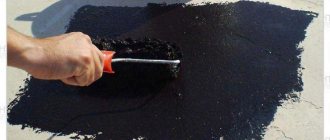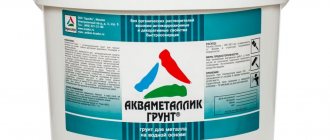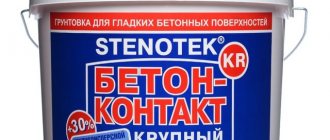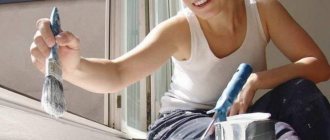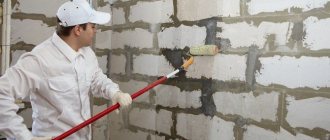Peculiarities
Acrylic primer is a liquid solution based on acrylic dispersion and special components. The peculiarity of this composition, first of all, lies in its protective qualities. The mixture is well absorbed into surfaces that have a porous structure, thereby strengthening the base. When the solution dries, a high-strength protective film is formed on the surface, which, in turn, improves adhesive properties and helps reduce the consumption of paint or adhesive material.
Acrylic primers may vary in composition and some properties. However, all acrylic-based mixtures have common features and characteristics:
- the soil makes the treated surfaces more durable, especially if a deep-penetrating or strengthening mixture is used;
- reliable protection against moisture: the film created on the surface repels water;
- increases the level of adhesion: the finishing coating will adhere well to the primed base;
- reduces the consumption of paint and varnish or adhesive mixtures during finishing;
- vapor permeability;
- good covering ability: dark-colored surfaces treated with acrylic primer will not show through under the finishing layer of light-colored paint.
Acrylic-based mixtures may contain a different set of components. However, acrylic primers also have common substances in their composition:
- water or organic solvent as a base;
- binding elements that provide the solution with a certain viscosity: drying oil, various resins, polymers;
- dyes;
- catalysts that speed up the drying process of the primer mixture;
- special additives that give the solution certain qualities: antifoaming agents, biocides.
Acrylic painting techniques
There are many techniques for painting with acrylic paints, let's look at some of them.
Glaze
Glazing is when translucent diluted paints are applied successively and thinly layer by layer, allowing the previous coating to dry. As a result, the image acquires depth and volume. The shades do not mix, so a very beautiful artistic effect is achieved. The colors are always applied unmixed, as they must come together directly on the canvas. For example, to get a greenish tint, first apply translucent yellow and then translucent blue.
An example of glazing can be seen in the video
"Dry" technique
With the dry technique, the brush is not pre-wetted in water, but is immediately picked up with paint and thus applied to the base. After each rinse, the brush should be wiped dry. This technique gives very clear transitions between different colors, the effect of texture, the natural unevenness of the surface of an object, for example, when depicting fruits, flowers, animals.
How to draw using this technique is shown in the video
Imitation watercolor
To create a beautiful watercolor effect, acrylic is heavily diluted with water. Place paint on the palette, add water, mix and apply to canvas. The more water you add, the more transparent and subtle the shade will be. Sometimes a spray bottle is used for this purpose: under the influence of settling droplets of water, acrylic disperses over the surface, like watercolors.
Specifications
The properties of acrylic primer mixtures may vary slightly depending on the composition. When purchasing an acrylic-based solution, you should pay attention to the following technical characteristics:
- Mixture consumption. It is worth considering that the consumption of the mixture depends on the material from which the structure being treated is made, the type and form of release of the priming solution. More accurate indicators of consumption per square meter are always indicated in the list of technical indicators on the product packaging. It is worth remembering that aerosol mixtures are used up the fastest.
- Best before date.
- Presence of toxic components in the composition. This indicator is especially important when work will be carried out indoors. To minimize harm to health, it is better to purchase environmentally friendly formulations without organic solvents.
- Purpose of the primer composition. For almost every type of base, a separate acrylic primer with special additives is produced. If you need to treat several surfaces made of different materials at once, you can use a universal composition.
- Release form. Dry powder primers are extremely rare. Most often, the solution is sold ready for use. The consistency of the primer can be paste-like or completely liquid. Acrylic primer is packaged in buckets of various sizes or produced in the form of an aerosol in cans.
- Complete drying time.
Preparing for painting
Priming is preceded by a thorough preparatory stage.
Preparation and priming steps:
- Degreasing.
If the material is painted, the old coating is removed. The exception is colorants of the same type as the new coating. That is, acrylic paint can be used to cover old paint if it is made on the basis of acrylic. But for this it is important that the old layer is durable and does not delaminate.
Degreasing wood
For degreasing, use turpentine, acetone or universal removers. The first two products are applied with a rag 3-4 times. The resin pockets are filled with the selected solvent and blotted with a swab. Removers are used when it is necessary to remove old coating.
- Application of antiseptic.
To prevent the tree from rotting over time and becoming an abode of woodworms, the material is coated with an antiseptic primer once using a roller or a wide construction brush.
Often such mixtures contain flame retardant additives, which increase the fire resistance of the coating.
Antiseptic
- Puttying.
At this stage, they get rid of cracks and minor defects, hide seams and recesses from cutting into self-tapping screws, so that the varnish and other decorative means adhere better. When painting, it is recommended to give preference to acrylic products, which are more elastic. The composition is applied in two stages, since the acrylic product will shrink after drying.
If you plan to apply a transparent varnish to the base, then for puttying it is better to create your own composition from sawdust and PVA. This product is transparent and will not shrink after drying.
Homemade putty
- Grinding.
The procedure is performed after puttying. Movement is allowed only in the direction of growth of wood fibers. To do this, use sandpaper or a belt sander.
- Treatment with penetrating primer.
This layer is designed to increase the strength of the material, increase its adhesive properties and reduce paint consumption.
Composition of acrylic primers
The composition mainly varies depending on the application. However, there is a set of standardized components:
- Aqueous or organic dispersion.
- Additives that increase the viscosity of the soil (various resins or drying oil).
- Drying accelerators.
- Auxiliary additives (particles of marble, chalk, mica).
- Specialized components that impart special qualities (antiseptic substances, ethylene glycol, defoaming agents, etc.).
- Tint pigments.
The characteristics of acrylic primers may vary depending on the quantitative proportion of a particular component in the composition.
Do I need to prime the walls before painting?
Novice finishers do not always understand why preparatory work is carried out. It seems to them that the most important thing is to level the base, then they can safely paint. In fact, this is not entirely true. Indeed, before painting it is very important to level the coating. There should be no differences, cracks or other defects. Therefore, the first step of proper preparation is alignment. It can be made in different ways: drywall, plaster, etc.
At the last stage, finishing putty is most often applied, which will become the base for painting. The next required step is priming. It is necessary because the soil:
- Strengthens the base. It binds weak, porous and loose surfaces into a single whole, making them more durable. Deep penetration formulations cope especially well with this. They are capable of going deeper by 80-100 mm, while conventional preparations do not go deeper than 20-30 mm.
- Improves adhesion or bonding of finishing material and base coat. Thanks to the primer, the paint stays better on the surface, preventing it from peeling and cracking. Moreover, during subsequent repainting it will be easier to prepare the base for work.
- Reduces coating consumption. After treatment, the absorbent properties of the base are significantly reduced. Thanks to this, about a third less composition will be required for finishing.
There are materials with special properties. They can increase the moisture resistance of the surface, prevent mold, etc.
Special primer Tikkurila Otex Akva 0.9 l
1 567
Buy
- Walls
How to prepare walls for finishing
Types of acrylic primer
Acrylic wall primer has three release forms:
- Dry mixture (concentrate) requiring dilution with water. The advantage of this composition is the ability to regulate the consistency of the composition.
- Ready solution. Does not require preparation, which reduces finishing time.
- Soil mixture in a can. The advantage is that it is economical to apply, but it is irrational to use for work on the entire area due to the small volume of the can.
According to their intended purpose, acrylic-based primers are divided into several groups:
Acrylic primer of deep penetration (deep)
The peculiarity of the soil is its ability to penetrate into the base by more than 10 cm, strengthening it both outside and inside. Area of application: loose, old or poorly absorbent surfaces.
The penetrating effect is achieved through the use of latex, which breaks through the thickness of the base and binds it into a single durable surface. A deep penetration acrylic primer improves the quality and durability of the finish, and also reduces the consumption of finishing materials.
Acrylic adhesive primer
The composition is characterized by the presence of quartz or other fine-grained fillers, through which the adhesion of the base to the finish is improved.
The primer is excellent for treating poorly or non-absorbent surfaces such as glass, ceramic tiles or plastic. Very often acrylic adhesive primer is produced tinted in any color. This allows you to identify undeveloped areas of the base.
Impregnating primer
Used for surfaces with uneven absorbency. Often the impregnating primer is applied in several layers, which ensures regulation of moisture absorption of the base.
Fixing primer (strengthening)
The advantage of soil is the gluing of small particles that serve as a kind of cement, filling pores and voids on the plane. The composition does not tend to penetrate deep into the base.
It will simply fix loose or dusty areas. Fixing primer is very often used for treating mineral substrates characterized by a certain amount of chalking.
Universal acrylic primer
It combines the functions of all previously listed types. The soil is capable of penetrating deep enough into the base, making it rougher, leveling the absorbent properties of the surface, and securing it.
However, combining several functions, the universal acrylic primer is not as effective as each type previously discussed separately.
Special primer for walls, acrylic
- anti-corrosion;
- light and color fast;
- antiseptic.
Acrylic primer, the composition of which may vary according to purpose, is also classified depending on the type of solvent:
- Organosoluble primer , made on the basis of organic resins. This composition tends to protect the base from various influences and the proliferation of fungal cultures. This acrylic primer has a fairly small consumption - about 80 g. Per m2. The scope of application is most often facade processing.
- Acrylic water primers (water-soluble or water-dispersible). They are used primarily for interior work, since they are not resistant to adverse environmental influences. Eco-friendly and non-toxic. Used to level out absorbent properties, strengthen and secure bases.
In addition, the primer is acrylic, the price of which ranges from 289 to 550 rubles. for 10 l. ready-made solution is made taking into account the type of base. There are:
Acrylic anti-corrosion primer
Used for processing metal surfaces. The composition of the primer can be made either based on water or using latex resins. The main composition must include components that prevent metal corrosion.
Anti-corrosion primer protects the metal by creating a waterproof film not only from moisture, but also from other negative influences. It is used both for further painting and as a finishing layer. Such primers include alkyd acrylic composition.
Primer for wood
Painting with an acrylic primer of this type provides the wooden base with protection from mold, rot and insects due to the presence of antiseptic components in the composition. In addition, the soil is endowed with antibacterial properties. Wood primer also improves adhesion to the finish and increases the strength of the surface.
Acrylic primer for concrete
The composition is also suitable for use on other porous substrates. Traditionally, concrete primer is used for further painting with enamel paints and varnishes.
Acrylic primer, the technical characteristics of which are described below, complies with the domestic standard GOST R 52020-2003.
Specifications:
- Density – 1.00 -1.03 g/cm³ at a temperature of 20 degrees;
- Conditional viscosity at temperature (20±0.5)°С – not less than 40-42;
- Drying time – 30-120 minutes;
- Temperature for application – not lower than +5°С;
- Application method: spray gun, brush, roller;
- Acidity (PH) – 5-9;
- Consumption when applied to wood in 1 layer – 90 g/m2;
- Consumption when applied to concrete, brick, stone, etc. – 120 g/m2;
- Consumption when applied to plasterboard – 60 g/m2;
- Shelf life – 2 years.
Sizing and primer
|
primer
is an intermediate layer applied to the base. His task:
- ensure a strong bond between the base and the paint layer
- create the desired color background and texture.
Sizing
under primer – a layer applied to the base. Her task:
- isolate the canvas (cardboard, paper, board) from oil paint. On an unglued base, the oil from the paint penetrates into the cellulose, and the free fatty acids contained in the oil partially destroy it. As a result, cellulose becomes brittle and easily breaks under mechanical stress.
- if the fabric has a rare weave, then the adhesive film additionally closes the holes between the threads. This is achieved by applying several sizing 2-4.
When sizing the canvas, the task is not to wet (soak) it through, but to apply a protective film to the front side. Therefore, they use a 5% glue solution, which has the consistency of jellied meat. With such a viscosity, it will be slightly absorbed into the threads, but enough for strong adhesion to them.
Gluing on the Peredvizhniki network.
TYPES OF SOIL
1. Adhesive primer
Designed for oil painting
Compound:
a mixture of gelatin glue solution with chalk/a mixture of chalk and white (1:1). Glue: carpenter's glue - more fragile, fish glue - dense and elastic. To prevent cracking of the soil, a plasticizer is introduced.
Basics
, on which the adhesive primer is applied: all bases
Advantages
adhesive primer:
- Ready to go in two to three days
- Oil paints adhere well to it, dry quickly and do not crack.
Flaws
:
- If the proportions are incorrect, the soil may become too loose or “pulling”. The soil is capricious and unpredictable.
Note: only gelatinous, cooled glue is applied under the adhesive primer as a sizing agent.
Adhesive primer in the Peredvizhniki network.
2. Emulsion primer
Designed for painting with oils, water-soluble paints (since it is insoluble in water) and in various techniques: “a la prima” - wet painting, multi-layer painting, glaze painting
Compound
: “pigment + emulsion”. An emulsion (emulsion binder) is prepared from two immiscible LIQUIDS: a glue solution (for example, gelatin or casein) and linseed oil.
In terms of its properties, it occupies an intermediate position between adhesive primer and oil primer.
Basics
to which emulsion primer is applied: all bases
Advantages
emulsion primer:
- Ready for use in 2-3 days (but it is advisable to keep it for up to 2 months)
- A layer of emulsion “envelops” the grains of the canvas without clogging their structure
- "Medium-tensile" soil. Less porous than adhesive. Therefore, oil paints on such a primer lose less of their tonality.
Flaws:
- A poorly prepared emulsion leads to the appearance of yellow oil stains on the ground or the painting's canvas to wither.
- It is unstable (that is, after a fairly short period of time after preparation, the primer begins to disintegrate into components), so it is not sold for self-application. Manufacturers themselves prime their canvases with emulsion primer.
3. Oil primer
Designed for oil painting.
Compound
: zinc white, slightly diluted with oil. Not all types of zinc white are suitable for oil-based primers.
Basics
to which oil primer is applied: all bases
Advantages
:
- Oil primer almost does not absorb oil from paints and therefore does not change their tone
Flaws
:
- A long period of drying, at least one year, is required. But you can’t overdry it, because... overexposed oil primer does not adhere well to the paint layer.
- Low porosity. Therefore, due to poor adhesion of the paint layer and the primer, relief, impasto painting is impossible on an oil primer.
- According to restorers, paintings can peel off from oil-based soils because they do not bind sufficiently to the soil due to its low porosity.
Recommended
for artists who love high-gloss paint, deep-color painting and glaze writing.
Note: a weak hot solution of gelatin (1:200) is applied under the oil primer as a sizing agent. It is better to use adhesive sizing, rather than acrylic, because adhesive is pulling, so adhesion to oily soil will be better. Also, adhesive sizing gives the desired tension to the canvas.
Oily soil in the Peredvizhniki network.
4. Acrylic primer
Designed for painting with oil paints, acrylic, tempera
Compound
: “pigment + dispersion”. Dispersion: tiny transparent particles of resin (acrylic or polyvinyl acetate (PVA)) float suspended in water.
Basics
on which acrylic primer is applied: any base. Use with caution on canvas. Soft acrylic primers on fabric give the entire structure excessive flexibility, which is unacceptable for an oil film. They are more suitable for oil painting on stiffer (canvas-type) polyester fabrics.
Sizing: the first sizing (Gelatin, PVA) is required before applying to the surface of the canvas; Treatment for wood and cardboard is optional.
Advantages
: Quick-drying, Opaque, Elastic
Flaws
:
- short history of use (about 50 years). It is not clear how acrylic primer will manifest itself after centuries
- acrylic sizing does not give much tension to the canvas. Therefore, there is always a risk: if you push the canvas while working, it will be difficult to restore its tension without pegs.
Soil type
: medium-drawn.
When chalk or gypsum is added to acrylic or adhesive primer, Gesso
. It is characterized by strong paint absorption (strongly pulls the binder out of the paint layer). If it is necessary to create a primer with a very smooth texture, Kaolin (white clay) is mixed with chalk.
Acrylic primer in the Peredvizhniki network.
4. Gesso gesso primer
Designed for painting with oil-casein and egg tempera.
Compound:
glue solution + plaster/chalk. Gesso soil is durable due to the gypsum. Each dried layer must be moistened with water to prevent cracking. Each layer must be sanded with sandpaper.
Basics
on which gesso primer is applied: all bases except canvas - thick plywood, fiberboard (fibreboard), hardboard, board
The final coating layer is a 5% glue solution.
Gluing under gesso primer – 5% gelatin solution/fish glue/wood glue. After drying, a wire (for example, gauze) is glued on; Before use, the wire is dipped into the adhesive solution, squeezed out and glued.
Tip: when working with oil-casein tempera, you should use low-fat milk rather than water to thin the paints, because it contains casein, which promotes good adhesion of paints to gesso soil.
Soil type
: strong pulling.
5. Gesso acrylic primer
Designed for painting with oil, acrylic, tempera, gouache.
Compound:
acrylic dispersion + gypsum/chalk.
Basics:
all the basics. Use with caution on canvas.
Sizing under primer – for canvas: gelatin or PVA. For other bases, sizing is not necessary.
Soil type:
strong-pulling
GESSO soil in the Peredvizhniki network.
TYPES OF SOIL
The less binder in the soil, the more “pulling” it is.
"Pulling" soils
(adhesive and emulsion/acrylic based on chalk) – they take a lot of oil from the paints, thereby giving the paint layer a matte tint. Before starting work on such soils, they must be wiped with an oiled swab.
"Medium-tensile" soils
(emulsion/acrylic based on white) before work are glued with a weak solution of gelatin (1:100)
"Low-tensile" soils
(oil-based) - practically do not remove oil from paints, but the adhesion of oil paints to the soil is weak, the paints crumble
PREPARE THE SOIL YOURSELF
You can prepare the soil yourself:
1. Binder for adhesive primer:
- Glue: Gelatin. From it we get a 5% glue solution (25 g per 500 ml of water)
- Plasticizer: Glycerin. Consumption 5-10 ml per 25 g. dry gelatin
Binder for oil primer:
- Flaxseed oil
- Poppy oil
- Nut butter
- Binder for oil paints
2. Primer pigments
- Chalk - packed in 100/500/1000 g. (but not construction)
- White pigment: Zinc oxide - zinc white 100/200/500/1000 gr.
- White pigment: Titanium oxide - titanium white 100/200/500/1000 gr.
FAQ
— Is it possible to use regular paint as a primer?
Soil is necessarily diluted with water
binder + a lot of pigment.
If you use an undiluted
binder, i.e. paint, you will get an oilcloth coating to which the painting will not adhere well. The diluted binder, when the water dries, leaves the finest capillaries-pores in the soil. The binder from the paints is partially absorbed into these pores and creates a strong connection between the painting layer and the soil.
— How many layers of primer should be applied?
The number of coats of primer applied is a matter of personal preference; however, it should create a smooth, even finish. Typically, artists apply three to seven coats of primer. The degree of its absorption, as well as the tension created by the binder, increases depending on the thickness of the layer. Experts advise applying the top layers of primer less thick than the bottom layers to avoid the worst effects inherent in film tension. To minimize the risk of board deformation, primer should be applied to both sides of the board as well as the edges (the back of the board does not require the same attention as the front).
— What is the best tool to apply primer?
Apply the primer using a flute or a palette knife with a rounded end. Under no circumstances should you brush the brush several times over the same area, otherwise the primer will come off in places and will not provide an even coating. When applying different layers, it is necessary to ensure that the texture of the canvas is not clogged. For uniform priming, it is better to apply more thin layers of liquid primer than one or two thick, thick layers.
— Is it possible to paint on oil primer with acrylic and vice versa?
1. Acrylic on oil
: oil primer must dry out well (at least one year). Next, you need to clean the surface with a swab containing pure pinene or mineral spirits (No. 2) and let it dry thoroughly. If liquid acrylic rolls into droplets on an oil surface, then dilute the acrylic with water with the addition of ox bile (the ratio of water and bile using a test method) until the paint stops rolling into droplets and begins to lay down in an even stroke.
2. Oil on acrylic primer
. The acrylic primer must dry well. Further, no problems arise.
— What soil is ideal for oil?
Emulsion and acrylic primers
universal and suitable for any equipment. When working on canvas, it is better to use emulsion primer.
Oil primer
, after application to canvas, it is recommended to leave it for up to six months for the oil to polymerize in it. If this is not done by the manufacturer, then in the future the connection between the painting layer and the ground may weaken. As a result, in case of mechanical damage, the painting layer peels off from the canvas.
Additional materials For stretching and priming the canvas, the following are used: strips for stretcher frames, tools for stretcher frames, unprimed canvas, flute brushes, etc. All necessary materials can be found on our network.
Manufacturers
To get a good result when priming a particular surface, you should purchase only high-quality mixtures with high technical characteristics. Before purchasing an acrylic-based primer, you should familiarize yourself with the leaders in the production of paints and varnishes and the products they offer.
San Marco
The Italian company San Marco occupies a leading position in the industry of production and sale of paint and varnish products for professional construction. The company supplies its products to more than a hundred countries around the world. New technologies are regularly introduced at San Marco production sites, which allows us to constantly improve the quality of products and develop new modifications of materials.
Concentrated acrylic-based primer San Marco Portici is intended for interior work. The mixture can be applied to plaster, concrete surfaces and drywall sheets. Portici primer mixture penetrates deeply into the structure of materials, thereby strengthening the base. The solution improves the adhesion of walls to the finishing coating.
Portici water-soluble primer can be applied in just one layer, which significantly saves mixture consumption. The drying time of the solution is forty minutes. If it is necessary to apply a second coat, it is recommended to wait four hours after applying the first.
"Lakra"
specializes in the production of paints and varnishes. All products are manufactured using modern imported equipment. The materials are made from high-quality foreign raw materials. Products undergo quality control at all stages of production.
produces a wide range of acrylic-based primers. The mixtures differ in their composition and purpose, which allows you to choose the appropriate composition for any job and surface.
Almost all acrylic-based primers contain fungicides.
"North"
produces a wide range of modern construction and finishing mixtures. Paint and varnish materials are superior in quality and technical indicators to many analogues, both Russian and imported. The enterprise has implemented scientific laboratories for the development of its own unique technologies for the production of materials.
Acrylic mixture "Nortex Ground" is intended for treating wooden, concrete, brick and stone surfaces indoors and outdoors. The primer can also be applied to plaster or plaster walls. The “Nortex Grunt” solution contains antiseptic components, which allows you to protect the processed materials from fungal growths and mold.
The primer forms a colorless coating. However, you can add colors of the desired shades to the mixture. The acrylic solution strengthens the structure of the impregnated material and improves adhesion to the finish coating
This composition is excellent for treating various surfaces before painting, as it significantly reduces the consumption of paint and varnish material.
"Empils"
is one of the largest manufacturers of paint and varnish products on the Russian market. All materials are manufactured using advanced technologies and meet international quality standards. Paint and varnish coatings are distinguished by their versatility and environmental friendliness.
The polyacrylic primer mixture "Oreol", produced by , is water-based. The product is notable for its low price and versatility. The primer contains antiseptic additives, which allows the solution to be used not only for interior but also for exterior use.
The "Oreol" primer protects the base from the appearance of fungi and mold, and also evens out the absorbency on all areas of the surface. The mixture is available in ready-to-use form. The complete drying time of the solution is no more than one hour.
Types of primers with acrylic
Acrylic-based primer can have different properties, taking into account certain tasks and surface properties. For each specific job there is its own type of acrylic mixtures.
By purpose
Depending on the technical characteristics and purpose, the acrylic primer can be:
- Deep penetration. This acrylate primer glues small particles together and fills the porous surface, helping to level it.
- Deep is an improved composition of deep penetration soil. Can penetrate surfaces up to 15 cm, used to treat walls made of old concrete.
- Impregnating. Used to smooth rough walls.
- Adhesive. Improves the strength of the finish, but has weak absorbent properties.
- Universal, having fastening, adhesive and impregnating characteristics.
- The polyacrylic mixture is characterized by high protective and strength properties, but it is also the most expensive and has increased consumption.
By type of solvent
Depending on the type of solvent, the primer can be of the following types:
- Water soluble. It is made on a water or latex basis. Dries quickly, practically odorless, excellent for both interior walls made of plaster, OSB, brick, and for exterior use.
- Organosoluble. It is made on the basis of organic solvents. Improves protection from the negative effects of the external environment, prevents the appearance of fungus.
Depending on the surface to be coated
Strengthening primer is also manufactured taking into account the characteristics of specific surfaces:
- Adhesive. Used for concrete surfaces (concrete blocks, ceilings, floors) with poor moisture-absorbing properties. Used for plastering or painting.
- Deep. Used for treating plasterboard walls or other moisture-absorbing surfaces. This makes drywall much stronger and improves its moisture-repellent properties. Treat before painting or wallpapering.
- For wood and metal. For wood, a one- or two-component composition is used, taking into account the characteristics of the room. For metal, as a rule, a water-based primer with additives is used to protect against corrosion. The compositions are used for painting or can be the final stage of repair.
- Water-dispersed. One-component primers are suitable for treating wood and OSB surfaces. You can add a certain color to the composition for a tint, which will improve the quality of further painting or highlight the texture of wood coated with colorless varnish.
Attention: To check the properties of the acrylic primer yourself, you need to apply the composition to the surface once with a roller. If a varnish film appears, then this is a strengthening primer. Deep penetration soil leaves almost no marks on the wall.
Calculating the consumption of acrylic primer
To calculate the required amount of soil, it is necessary to determine the area of the surface to be treated and find out the consumption per 1 m2, which is a fundamental value and is usually included in the instructions for use from the manufacturer. Moreover, many instructions indicate consumption rates depending on the surface structure.
You can also use approximate average standards for estimation, such as in Table 1.
Table 1. Soil consumption rate for the intended surface.
Table 1
However, the actual consumption rate may not coincide with that indicated in the instructions and in any table, since it depends on many subjective factors: climatic conditions, unevenness and damage to the surface, etc. The most accurate way to determine standards is by test application on an area of 1 m2.
The release form also affects the accuracy of the calculation. The easiest way is to calculate ready-made solutions. Concentrated primer and dry powders are more difficult to calculate (since everyone adjusts the consistency at their discretion). It is especially difficult to calculate consumption for soils produced in cans.
Priming metal before painting – why primer?
Each metal primer contains special substances - inhibitors. They protect metals from their inherent self-destruction through corrosion. In addition to their protective properties, primers are used to ensure the best adhesion between the surface to be painted and the paint composition, which is especially important for zinc and aluminum.
For aluminum, zinc-based primers or paint . It is optimal to treat steel with a primer containing zinc phosphates or its metal powder. Copper, bronze and brass are usually not painted, but coated with epoxy or polyurethane varnish if necessary.
Advantages and disadvantages of acrylic-based primers
The main advantages of the material are due to the presence of unique binding agents in the composition. The acrylic primer has quite universal technical characteristics, which makes it extremely popular among buyers.
The first thing to note is the adhesive properties of the soil. The liquid part of the composition gradually dries out into a film that literally attracts the finishing material to the surface. This ensures the durability of the finishing layer.
At the same time, the acrylic-based primer perfectly penetrates into the thickness of the base, strengthening it from the inside and turning even loose walls into monolithic ones. The surface becomes stronger and more reliable due to increased density and the acquisition of a homogeneous structure.
The thinnest film formed by the soil increases the moisture resistance of the base. Therefore, acrylic wall primer is especially often used for treating surfaces in damp rooms or surfaces located at the ends of the house (corner walls).
The elasticity of the composition allows it to cover any type of surface, which indicates its versatility. The primer can safely be used to treat concrete, wood, including chipboard and fiberboard, plasterboard and gypsum fiber, asbestos-cement, plastered, plastered and other substrates.
Due to their environmental friendliness, water-based primer coatings can be used in any room.
Painting with acrylic primer ensures equalization of the porosity of the base. To do this, you need to treat the surface several times. This reduces the consumption of finishing materials (putty, paint, wallpaper paste), since a uniformly absorbent surface will not tend to excessively absorb the finish.
Cost-effectiveness of use is another advantage. The dry type requires kneading. The result is more than 10 liters of the finished composition. Considering the cheap cost of concentrated soil, the costs will be minimal.
Regarding the disadvantages, it should be noted that water-dispersed compositions do not have any, except that the consumption of a dry acrylic primer diluted with your own hands may be slightly higher, which is associated with an insufficiently accurate selection of the ratio of water and suspension.
But organosoluble soils are not environmentally friendly. That is, when applied, some toxicity is observed, and therefore they are intended more for external processing.
The characteristics of acrylic primers indicate the uniqueness of the composition, which combines all the requirements for a primer for interior work. Existing specialized compositions make the scope of application of the primer coating unlimited.
Before gluing wallpaper, plastering or puttying a wall, it is advisable to treat it with a primer. At first glance, it is not entirely clear why to do this? Wood, concrete or brick treated with a primer is visually, and even in the photo, practically no different from untreated wood. The fact is that the primer gives the wall waterproofing properties, improves the adhesion of wallpaper, putties and plasters, and also reduces material consumption.
What is a metal primer?
Answering this question, first of all, it should be noted that a metal primer in ready-to-use form is a suspension solution. The solvent can be different: water, oils, white spirit and other alkyd solvents.
Attention! If soils containing organic solvents are applied indoors, it must be ventilated. You should work in protective gloves, goggles and a mask.
In addition to soluble salts, there is a solid phase - a set of pigments and other fillers. Each composition has its own set of ingredients and its own characteristics, which determine where this soil is used.
Metal profile primer
When priming, both components that change the characteristics of metals (the ability to interact) and their oxides (rust reduction), and the hard film that the hardened primer forms can serve as surface protection. Priming solutions can be produced in one-component ready-made form or in two-component form. In the latter case, hardeners for film formation are added to the base compositions immediately before work.
Metal profile primer
Many primer coatings for metal surfaces can serve not only as protection, but also as an excellent base for subsequent topcoats. Anti-corrosion primers-enamels are also being produced and are becoming increasingly popular. These self-sufficient compositions have such important decorative features as color variety and the ability to choose the degree of gloss from matte to glossy.
To make it easier to choose primers and enamels for metal surfaces, in the next chapter we will give a short overview of their types.
What to look for when purchasing
To ensure complete protection of the material from the adverse effects of the environment and to obtain long-term high results during final finishing, when purchasing acrylic primer, the following must be taken into account: Type of base. For a base consisting of dissimilar materials, a universal primer is well suited. For homogeneous walls or floors made of wood, brick or concrete, it is better to select compositions taking into account the individual characteristics of the material. Subsequent type of finishing. If the OSB board or wood is subsequently painted or coated with transparent varnish without color, then you should pay attention to the tinting of the mixture. If wallpaper is glued to the walls as a final covering, then the color of the primer does not matter.
The presence of “bonus” substances that give the processed material additional properties (strengthening, fire-retardant, antiseptic, adhesive, anti-corrosion). What additional components are available and their share must be indicated in the certificate. Economical. As a rule, acrylic primer containing water as a solvent has a small mixture consumption per 1 m². Soils containing organic resins as a solvent are less economical; their consumption per m² will be slightly higher.
The attached instructions always indicate how much material is required per 1 m². Type of work: external or internal (for walls outside the house an acrylic facade primer must be purchased). Environmentally friendly. This characteristic should be taken into account when choosing acrylate preparations for treating walls and floors in residential premises. How long does it take to dry? Acrylic primer, which has water or a latex base as a solvent, dries very quickly and has almost no odor. Availability of a quality certificate. By purchasing a cheap product on the market without a certificate, you can buy a low-quality fake, the use of which will affect the quality of subsequent work. By asking the seller for a certificate, you can protect yourself from purchasing a low-quality product.
In addition, it is worth paying attention to the release form of the drug. Acrylate primer mixtures can be sold: In the form of ready-made solutions, which must be mixed well before use. The certificate and instructions always indicate approximately how much of the drug is consumed when processing 1 m² of area. In the form of a concentrate, when the solution is brought to the required consistency immediately before use. Purchasing primer-acrylic in the form of a concentrate is much more economical and allows you to achieve the required viscosity of the product, depending on the quality of the base. The concentrate can be diluted not all, but as much as is needed for work, because it is stored longer than the finished mixture. In cans that need to be shaken well before use. Purchasing the soil mixture in cans ensures ease of use and low consumption per 1 m². The downside is the small volume of containers and the need to calculate how many cans you need to purchase to work on large areas. A little inconvenient when processing the floor.
Procedure for working with acrylic paints
Acrylic dries very quickly, so you won't have much time. Therefore, first make sure that the workplace is completely ready:
- you are wearing an apron, the table is covered with film;
- jars of clean water;
- brushes and palette knife;
- wet palette;
- paints;
- paper scraps - use them to remove excess paint;
- rag for brushes;
- prepared canvas;
- the light comes from the left (if you are right-handed).
Now you can start!
- Apply a small amount of paint to the palette, literally 5 mm. Thus, lay out several colors around the perimeter that you will work with. Leave a distance of a couple of centimeters between them.
- Take large brushes and paint the outlines of the largest objects on the canvas. The lines must be clear. It is more convenient to do this with opaque matte paints.
- Make more detailed drawings with small brushes with a sharp tip, using transparent and translucent colors.
- Every 10-15 minutes, be sure to spray your work with clean water from a spray bottle so that the paints do not dry out before you finish the painting. It is necessary that the canvas is as if in a water haze of tiny splashes.
- Before moving on to a new color, thoroughly rinse your brush of paint. This can be done under cold running water or in two jars of water: in one you wash the brush, in the other you rinse. Be sure to blot the clean brush with a rag so that not a drop remains on the bristles or the handle. This is important because moisture accumulated on the handle can fall onto the work and become a blot.
When everything is ready, leave the painting to dry for a day. After this, it can be coated with acrylic varnish and inserted into the frame.
Let's estimate prices
In the building materials market, prices for acrylic primers vary widely. The price is determined by:
- functional specificity of the soil itself;
- conditions dictated by the manufacturer and supplier;
- the place where the production is located;
- brand rating;
- filling with modifying additives (the more there are, the higher the price).
That is why it is important to know the level of quality that will be necessary and sufficient for each specific case - in order to make a rational choice of primer material.
Sometimes it is still possible to make a direct calculation of the feasibility of using a primer. For example, you need to apply concrete contact to a surface that is not completely wetted. Will there be significant savings from pre-treatment with impregnating primer of the same brand? Let's summarize prices and consumption rates in Table 2.
Table 2. Acrylic primer: consumption and price.
table 2
The table shows that in the case of using a preliminary layer of deep impregnation, we have a gain in terms of the norm by 2-3 times and for deep penetration soil the price is 1.5-3 times less.
In a similar way, you can estimate the economic feasibility of deep impregnation before applying any other primer. Acrylic primer, the price of which is the most favorable, is universal without any special additives. Therefore, if the surfaces to be finished do not have any particular defects and will not bear excessive operational loads, it is better to buy it.
GOODHIM GU universal acrylic primer with strong antiseptic additives, high latex content, environmentally friendly and safe for health, suitable for strengthening foundations in a wide variety of rooms, including those with high humidity. Able to bind dust, reducing water absorption, and adhere to non-absorbent substrates. It is very good from an economic point of view - the price is 153 rubles. for 5 liters.
Important! Saving primer materials should not be excessive. The primer must be applied without gaps, if necessary in several layers. Otherwise, it will not perform its functions sufficiently, which can lead to the loss of expensive finishing coatings.
Review of popular manufacturers
When purchasing soil from an unknown manufacturer, there is always a risk of buying low-quality products, while global manufacturers constantly monitor the quality of their goods. List of the most popular manufacturers:
- "Prospectors". The mixture has the ability to fill pores and small cracks. The use of quartz sand in the composition improves adhesive properties. It is permissible to use a primer for external and internal work.
- "Optimist". Acrylic primer is suitable for interior and exterior work. This is a mixture of latex with modifying additives and antiseptics. The mixture can be used to treat surfaces that are susceptible to the negative effects of moisture.
- "Tex." A universal mixture that penetrates surfaces up to 7 mm. Due to this ability of acrylic primer, it is used for facades and interior work. Can be used in rooms with high humidity.
- "Knauf". It is a leading global manufacturer in the construction market. Among the large assortment of primers from this company, one can note the polymer composition “Betonkontakt”.
A correctly selected primer, taking into account the required surface characteristics, will ensure the subsequent quality of the finish. The wallpaper will lay perfectly flat on a properly chosen primer, and the painted floor will not crack for a long time. The plasterboard wall will be protected from moisture, and the floor will enjoy a smooth surface for a long time.

